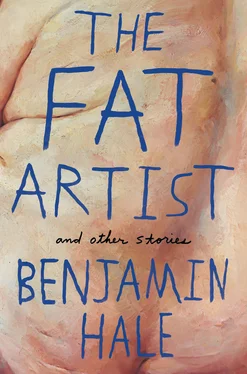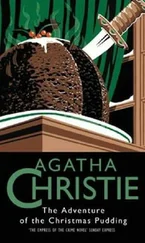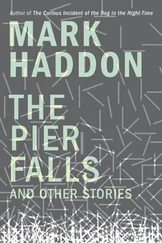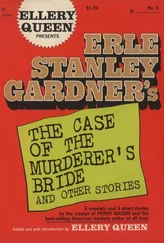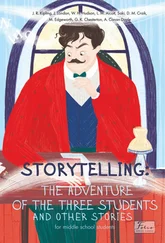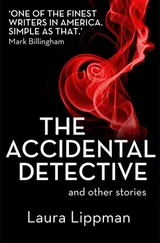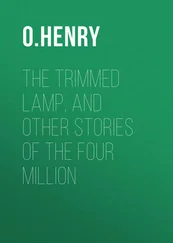I cried. I was stricken with a sharp panic — which expanded into a dull terror as the evening at last came on — that the world had forgotten me. And then, I was angry. To hell with “angry”—I was enraged. A hot flower of fury bloomed in the fertile soil of my wounded heart. I screamed and railed at my waiters. I waved my fat fists in the air, and in a voice hoarsened with bitter tears I demanded to know why Tristan Hurt, the inventor and sole practitioner of Fat Art, had become subject to neglect.
They shut my exhibit doors and turned their faces away.
I ate on.
• • •
Days passed. No one came to feed me. So I ordered my waiters to bring me great steaming piles of chicken, to bring me hundreds of pepperoni pizzas, hot and sodden with grease. Indeed, I had almost reverted to the diet of my year of solitude, the very foods that had made me fat to begin with. I looked down at my body. One would scarcely believe, seeing me, that buried beneath all this flesh was the stalwart and handsome man of six feet and an inch in stature and a mere 200 lbs (91 kg) that I had once been. Except for my head, I scarcely any longer resembled anything identifiably human. It would have been unjust to compare my body even to that of, say, a hippo. My body looked more like some large aquatic mammal that had washed up on a beach and died — it had the same floppy lifelessness to it, the same squishiness and dimpled, pulpy, rotten-looking texture. My flesh had developed a pallor and stickiness that seemed almost amphibian. My body was so soft and so giving that I was able to stick my arm into the folds of my stomach and sink it in all the way to the elbow before meeting any resistance.
Still, I had more weight to gain. I ordered my waiters to bring me food. They brought me eighteen pizzas for lunch. They brought me thirty-five Big Macs. They brought me forty packages of kosher beef franks and three gallons of half-and-half with which to wash them down. I do not know if the foundation was still paying for my emergency rations. I think my waiters had been given some sort of company expense card. They were probably out buying themselves three-martini lunches with it when they were not delivering me my own endless lunch. Parasites. They brought me twenty racks of pork ribs. One day they merely brought me thirty loaves of Wonder Bread, forty pounds of shaved Black Forest ham, and a gallon tub of mayonnaise. They told me to make sandwiches for myself, and then they disappeared for three days. No one came. They didn’t even leave me a knife. I had to spread the mayonnaise with fat, clumsy fingers. The ham spoiled fast; I ate it anyway. When they came back, they started putting their cigarettes out on me for fun. My nerve endings were buried many layers deep; I felt no pain.
I ate on.
• • •
A week or two later — though really, I had no idea how much later, but if I were to hazard a guess — Olivia visited me. I had not seen her in nearly a year and a half.
When she came, my preliminary food table had nothing on it. Like the forgotten idol of a vanquished tribe, no one had brought me any offerings for many days. The only visitors I had received in the past week or more were people who had come to visit the main wing of the museum and had somehow wandered into my exhibit by accident. My exhibition chamber was out of the way and difficult to find for ordinary patrons of the museum. To see the Fat Artist required museum visitors to follow signs taped to the walls directing them to an emergency stairwell and into the service elevators, which were the only elevators that went all the way up to the roof of the building, and if the people were not following a large crowd — as had been the case in the early days of the Fat Artist, when the exhibition first opened — then it was easy for people to assume they were in the wrong place, or were somewhere they were not allowed to be, and they would turn around. I had begun to suspect that the signs directing visitors to the Fat Artist had been mistakenly removed, perhaps by some well-meaning janitor who was not aware the performance piece on the roof was still ongoing.
On certain days, my waiters would simply open up my exhibit in the morning and then disappear, returning only twice in the day: once, at lunchtime, to drop off the food I had requested of them earlier that morning, and then again only when it was time to close the doors in the evening. I usually smelled beer on their breaths when my waiters came back in the late afternoon to shut the exhibit for the night. Sometimes they would not even show up to unlock my chamber until it must have been close to noon.
I worried that I would never achieve my minimum goal of 1,600 lbs (726 kg). I had managed to fatten myself all the way up to the impressive — but insufficient for my purposes — weight of 1,491 lbs (676 kg). I knew this weight comfortably put me in the positions of (1) the fattest human then known to be alive, and (2) second fattest human in all recorded history (Carol Yager was still well ahead of me). But with this knowledge came two piercing little fears. The first was the fear that I would not be able to surpass the daunting record set by the great Carol Yager in 1994. I had a mere 109 lbs (49 kg) to go before I tied with her, but my weight gain was slowing with every day of the public’s persisting disinterest in my important art. My second fear was that no one would even record it when I attained my desired peak weight — as it seemed that I, Tristan Hurt, had been forgotten, even by my caretakers. The ebullient young interns employed to bathe my body on Thursdays no longer turned up. I was extremely dirty, and much in need of a bath. My body had not been shifted in a long time, and I feared the bedsores that might be developing beneath me.
A few days before Olivia visited me, I had found myself begging a lost-looking group of Japanese tourists for food. They were the first visitors to my exhibit in many consecutive days. At first they seemed not to understand. They took pictures of me pointing to my open mouth and pantomiming the act of eating by picking up an invisible object on my barren dining table (my waiters had been negligent) and bringing it to my mouth, then histrionically rubbing my leviathan belly with both hands as I made yummy-yum-yum noises. One of them eventually figured out what I wanted, and, in a hesitant way that suggested she was not entirely sure if it was “okay” to interact with me, she opened her purse and produced a packet of M&M’s, which she tore open and dumped into my waiting palm. I crammed them all at once into my mouth, chewed with quick, greedy chomps, and swallowed. They laughed as they searched themselves for more food and took more pictures.
Olivia came to me wearing a pretty and simply cut white dress. My waiters had come back not long before to deliver my lunch — which was, as per my usual request, nine buckets of fried chicken and four two-liter bottles of Dr Pepper — and then left. I didn’t know where they were. They probably wouldn’t be back for the rest of the day. I had come not to rely on them to be there for me. They were not even bothering to clean my exhibition chamber anymore. They simply allowed the chicken bones and pizza boxes to lie on the floor exactly where they happened to land when I ineffectually threw them from my bed. The floor hadn’t been swept in weeks. A black and thrumming swarmcloud of flies was my only company.
I believe I was up to a respectable 1,510 lbs (685 kg) when she came to visit me. Unfortunately, she did not come bearing any food. My waiters had at least been courteous enough to arrange the nine buckets of fried chicken within my arm’s reach all around me on my bed. This is what I was eating when Olivia came to visit me. Rather than any food offering, she was holding a bouquet of blush-colored roses. Her off-blond hair was bound in a ponytail. I watched her emerge from the door to the roof and walk toward my exhibition chamber. It was a muggy, overcast day, the sky smeared with thick gray clouds and threatening rain. A purple umbrella in a compressed state dangled by the strap of its handle from one of her thin, knobby wrists. Olivia is a small woman, and I considered the fact that I was then about fifteen times heavier than her; and then, having nothing to do with the thought considered, put it away. On her feet were black and glistening medium-heeled shoes with an open toe. They were the most beautiful shoes I had ever seen her wear, and I wondered what, if anything, occasioned this outfit: the dress, the shoes, a string of pearls, I believe (though that may be my imagination encroaching on my memory). She looked as if she were on her way to a charity dinner. I listened to her shoes clop on the asphalt-and-tar surface of the roof as she crossed it on her way to my exhibition chamber.
Читать дальше
